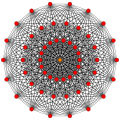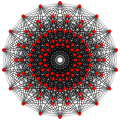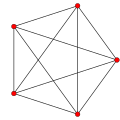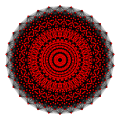Top Qs
Timeline
Chat
Perspective
2 31 polytope
Uniform Polytope From Wikipedia, the free encyclopedia
Remove ads
In 7-dimensional geometry, 231 is a uniform polytope, constructed from the E7 group.
Its Coxeter symbol is 231, describing its bifurcating Coxeter-Dynkin diagram, with a single ring on the end of the 2-node branch.
The rectified 231 is constructed by points at the mid-edges of the 231.
These polytopes are part of a family of 127 (or 27−1) convex uniform polytopes in seven dimensions, made of uniform polytope facets and vertex figures, defined by all combinations of rings in this Coxeter-Dynkin diagram: ![]()
![]()
![]()
![]()
![]()
![]()
![]()
![]()
![]()
![]()
![]() .
.
Remove ads
231 polytope
Summarize
Perspective
The 231 is composed of 126 vertices, 2016 edges, 10080 faces (triangles), 20160 cells (tetrahedra), 16128 4-faces (4-simplexes), 4788 5-faces (756 pentacrosses, and 4032 5-simplexes), 632 6-faces (576 6-simplexes and 56 221). Its vertex figure is a 6-demicube. Its 126 vertices represent the root vectors of the simple Lie group E7.
This polytope is the vertex figure for a uniform tessellation of 7-dimensional space, 331.
Alternate names
- E. L. Elte named it V126 (for its 126 vertices) in his 1912 listing of semiregular polytopes.[1]
- It was called 231 by Coxeter for its bifurcating Coxeter-Dynkin diagram, with a single ring on the end of the 2-node sequence.
- Pentacontahexa-pentacosiheptacontahexa-exon (Acronym: laq) - 56-576 facetted polyexon (Jonathan Bowers)[2]
Construction
It is created by a Wythoff construction upon a set of 7 hyperplane mirrors in 7-dimensional space.
The facet information can be extracted from its Coxeter-Dynkin diagram, ![]()
![]()
![]()
![]()
![]()
![]()
![]()
![]()
![]()
![]()
![]() .
.
Removing the node on the short branch leaves the 6-simplex. There are 576 of these facets. These facets are centered on the locations of the vertices of the 321 polytope, ![]()
![]()
![]()
![]()
![]()
![]()
![]()
![]()
![]()
![]()
![]() .
.
Removing the node on the end of the 3-length branch leaves the 221. There are 56 of these facets. These facets are centered on the locations of the vertices of the 132 polytope, ![]()
![]()
![]()
![]()
![]()
![]()
![]()
![]()
![]() .
.
The vertex figure is determined by removing the ringed node and ringing the neighboring node. This makes the 6-demicube, 131, ![]()
![]()
![]()
![]()
![]()
![]()
![]()
![]()
![]() .
.
Seen in a configuration matrix, the element counts can be derived by mirror removal and ratios of Coxeter group orders.[3]
Images
Related polytopes and honeycombs
Remove ads
Rectified 231 polytope
Summarize
Perspective
The rectified 231 is a rectification of the 231 polytope, creating new vertices on the center of edge of the 231.
Alternate names
- Rectified pentacontahexa-pentacosiheptacontahexa-exon - as a rectified 56-576 facetted polyexon (Acronym: rolaq) (Jonathan Bowers)[4]
Construction
It is created by a Wythoff construction upon a set of 7 hyperplane mirrors in 7-dimensional space.
The facet information can be extracted from its Coxeter-Dynkin diagram, ![]()
![]()
![]()
![]()
![]()
![]()
![]()
![]()
![]()
![]()
![]() .
.
Removing the node on the short branch leaves the rectified 6-simplex, ![]()
![]()
![]()
![]()
![]()
![]()
![]()
![]()
![]()
![]()
![]() .
.
Removing the node on the end of the 2-length branch leaves the, 6-demicube,
![]()
![]()
![]()
![]()
![]()
![]()
![]()
![]()
![]() .
.
Removing the node on the end of the 3-length branch leaves the rectified 221, ![]()
![]()
![]()
![]()
![]()
![]()
![]()
![]()
![]() .
.
The vertex figure is determined by removing the ringed node and ringing the neighboring node.
Images
Remove ads
See also
Notes
References
Wikiwand - on
Seamless Wikipedia browsing. On steroids.
Remove ads

















 ...
...












